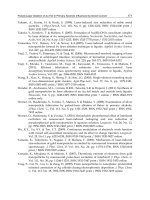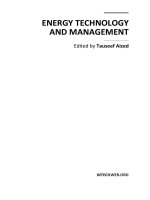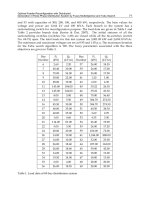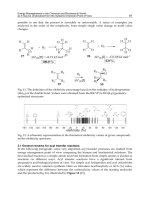Energy Technology and Management Part 10 pptx
Bạn đang xem bản rút gọn của tài liệu. Xem và tải ngay bản đầy đủ của tài liệu tại đây (1.92 MB, 20 trang )
9
Smart Home Services for a Smart Grid
Young-Myoung Kim and Young-Woo Lee
KT (Korea Telecom)
Korea
1. Introduction
A smart grid is a next-generation intelligent power grid, created by grafting ICT (Information
Communication Technology) onto the current grid, which allows power suppliers and
consumers to communicate on a two-way basis in real-time and to improve energy efficiency.
Current grids are based on a one-way communication structure where power is generated in
plants (utilities) and consumed in homes or buildings. However, in a smart grid, energy
delivery and consumption is optimized using a real-time power supply and consumption
data based on a two-way interactive communication structure. Therefore, as illustrated in
Figure 1, significant improvements are expected throughout the value chain from generation
to consumption in a smart grid.
For example, at the generation stage, even unstable intermittent renewable energy sources
like solar energy and wind energy can be connected to the grid and large-scale renewable
plants can be established. In addition, consumers would be able to generate electricity by
building solar or wind generation systems in their own home or building. At the
transmission/substation/distribution stages, information on devices and electricity in the
grid would be delivered in real time and reliable fault prediction, efficient outage
management and automatic self-repair (self healing) would become possible, ensuring a
supply of stable electricity.
The most significant change will take place in the consumers’ (home/building) stage, where
consumers will now be able to use or sell the electricity generated by distributed generation
using an energy storage device. Consumers will also be able to buy electricity when the
price
1
is low and sell when the price is high. Consumers will then be able to participate in
not only consumption, but also in generation and sales; they will be able to monitor the
price of electricity and the information on their energy consumption in real time and change
their consumption behavior accordingly.
However, in order to induce real participation from the consumer’s side, HAN (Home Area
Network) and home energy management systems have to be established first, and the
service has to be designed to be user-friendly and based on consumers’ values and needs.
In this study, we explored the perception of consumers and the value they experienced when
using electricity at home, to identify their unmet needs and suggest a few new services.
1
Utilities are expected to turn to new pricing schemes that adjust the price of electricity based on
consumption patterns. Utilities will curb consumption during peak periods when electricity is most
expensive, and shift consumption to those times when it is less expensive.
Energy Technology and Management
172
Afterwards, we carried out a survey to evaluate consumers’ willingness to use our suggested
services and lastly we made suggestions for a successful home service on a smart grid.
Nuclear power plants
Solar power plants
Wind power plants
Fuel cell plants
Electric vehicle
Battery
charging
station
Smart Meter
Home Server
Load Switch
Smart Thermostat
Gas/Water
Meter
Micro
Generator
Energy Display
Smart
Appliance
Connecting renewable energy to
the grid
- Unstable renewable energy(solar,
wind) will be connected to grid.
Self healing
- Stable power supplying by fault prediction,
outage management and self healing
sensor
Real time communication of devices and user
information In the grid
- two-way communication
Connecting distributed generation
to the grid
- Distributed generation in
Home/Building by solar or wind.
Energy storage
- Customers can use or sell
electricity generated by
distributed generation.
Generation
Generation
Transmission/Substation/Distribution
Home/Building
Smart Home
- Customers can monitor
electricity price and
consumption information
in real time and change
their consumption
behavior.
Fig. 1. The characteristic of a smart grid
2. Outline of the survey
There were two parts to our study. First, we explored the perception of consumers when
using electricity at home and the values they would like to experience qualitatively using a
HV (Home Visit) and a FGD (Focus Group Discussion). Afterwards, we carried out a
quantitative survey to evaluate our consumers’ willingness to use the suggested services.
Both studies were carried out in Seoul, Korea.
The HV was performed according to a FLC (Family Life Cycle)—young couples with no
children, families with children in K-5th grade, families with children in 6th-12th grade,
families with children in college and old couples in an empty nest. The HV was performed
in two stages; in the first stage, participants’ electricity usage behavior was examined
through observational studies and interviews and, in the second stage, changes in
perception and attitude toward electricity usage were explored after the participants used
electricity-saving products (an electricity inspector and an outlet timer) for some time.
The FGD was also carried out and the group was divided according to FLC in the same way
as the above. However, since the participants in these groups were all housewives, we
added one more group solely consisting of professional males. In the FGD, we completed a
cognitive map to show the value of using electricity.
Lastly, a quantitative survey was carried out with 300 participants who reside in Seoul,
Korea and use the electricity service. The sample was selected based on FLC and the survey
was completed by interviewing the participants face-to-face. The main purpose of the
survey was to identify the key values of using smart grid services and to test people’s
willingness to use our suggested services.
Smart Home Services for a Smart Grid
173
3. Customer perception and their values when using electricty
Three main perceptions and values when using electricity were derived by using a cognitive
map method. First, consumers perceived electricity as an ‘indispensable necessity’ that
makes the use of home appliances possible. Second, consumers perceived electricity as a
‘potential danger’ that emits harmful electromagnetic waves, causes short circuits and
electric shocks and suggested that they need to be safely protected from them. Lastly,
consumers perceived electricity as a ‘costly energy’ that needs to be saved on the user’s side
and they want the use of electricity to be stress-free.
Figure 2 shows a cognitive map of how consumers perceive electricity as an ‘indispensable
necessity’. Consumers regarded electricity itself as an ‘indispensable necessity’, but that
indispensability was often conceived as being connected to other home necessities such as a
refrigerator, PC, air-conditioner or TV. Consumers displayed positive perceptions using
words like warm, cool, bright and convenient toward electricity as it was deemed to be an
indispensable necessity in their lives.
Customers also exhibited some negative perception towards electricity; they regarded
electricity as a ‘potential danger’ that emits harmful electromagnetic waves and causes short
circuits and electric shocks. As a result of the above, consumers expressed the need for
safety during electricity usage. Figure 3 shows a cognitive map of how consumers perceive
electricity as a ‘potential danger’. In response to the various dangers that electricity usage
poses, consumers constantly try to mitigate the threat by placing charcoal or plants known
to absorb harmful electromagnetic waves in the house, dusting off outlets and unplugging
unused appliances.
Indispensable
necessity
convenient
Home
appliance
light
bright
warm
(cool)
To use
frequently
PC
fridge
TV
washer
Rice
cooker
Microwave
Air-
conditioner
Strong
relationship
Middle
relationship
Weak
relationship
Fig. 2. Cognitive map (1) : Indispensable necessity
Energy Technology and Management
174
PC
Rice
cooker
microwave
Potential
danger
Electromagnetic
waves
unhealthy
Trying to
avoid
uneasy
Electric
shock
wet
outlet
Dust
off
Pull the plug out
(when going out)
Short
circuit
bidet
Hair
dryer
Extension
cord
tiresome
TV
Strong
relationship
Middle
relationship
Weak
relationship
Fig. 3. Cognitive map (2) : Potential danger
Lastly, Figure 4 shows how consumers perceive electricity as a ‘costly energy’ that needs to
be saved on the consumer side. In Korea, electricity rates are cumulative, which means
consumers with a higher electricity consumption are charged at a higher rate. For example,
the electricity price per kwh when consumers use over 500kWh is 11 times greater than the
price per kWh when consumers use under 100 kWh. In this system, those who use more
electricity are charged at a more expensive rate. Because of this system, most housewives in
Korea are well aware of the cost of using electricity and feel the need to save money by
wisely consuming electricity. Each housewife has their own way to save electricity usage
but they are also feel tired of the pressure of being wise electricity consumer and are irked
by the wasteful usage of other family members.
4. Electricity usage behavior and unmet needs
4.1 Reducing electricity usage
Home appliances can be grouped in three categories based on how frequently they are used;
constant use, frequent use and occasional use. The first group is constantly used all
throughout the day, thereby needing the power to be on all the time, like a refrigerator. The
second group is used frequently throughout the day like a TV and PC and the last group is
used occasionally like a hair dryer. Consumers show concerns about the power usage of
appliances that are frequently used and try to turn off the power or unplug the cord in an
attempt to save electricity usage. Their persistence in their attempts to reduce electricity
usage depends on the nature of the appliance and its energy efficiency. For example, if an
appliance consumes a lot of electricity (e.g., an air conditioner) or it is simple to unplug, they
Smart Home Services for a Smart Grid
175
Costly
energy
Pull the plug out
(when going out)
money
Trying to buy
Efficient products
Want to know
Saving guideline
expensive
Cumulative
Electricity
rate
begrudge
Good for economy
& environment
nagging
obligation
(have to save)
Trying to
save energy
tiresome
stress
Don’t
know
Strong
relationship
Middle
relationship
Weak
relationship
Fig. 4. Cognitive map (3) : Costly energy
just pull the plug out. However, sometimes laziness or fear of electric shocks, particularly
from appliances like TVs or PCs that have many cables and complicated power
arrangements, discourages consumers from unplugging them. Consumers often read their
electronic bills thoroughly when the billed amount is higher than usual and compare their
bill with that of their neighbors in order to find what caused a rise in the bill. Consumers try
to reduce the use of appliances that use up much electricity and react sensitively toward
reducing electricity usage. However, they confess to feeling tired from nagging other family
members who react indifferently toward reducing electricity usage.
With regards to saving energy (reducing the use of electricity), most participants agreed
with its importance but evaluated themselves as not adequately meeting the standard. 99%
of participants indicated that they agree or strongly agree with the importance of reducing
electricity usage. However, only 48% agreed or strongly agreed that they are doing enough
to reduce electricity usage, showing that many consumers feel like what they are doing is
not enough in terms of saving energy.
Participants identified ‘lack of functionality’ in terms of controlling electricity usage, ‘lack of
information’ when informing consumers of their usage behavior and ‘lack of motivation’ as
the main reasons for their struggle to reduce electricity usage. They showed unmet needs in
the following areas: a function that blocks the power leakage of an appliance when not in
use, a function that informs the users on the level of electricity usage and the energy-
efficiency of each device, a function that notifies users of the cumulative rate
2
of electricity
usage and a motivator that pushes consumers to reduce their electricity usage.
2
The Korean electricity rate is a cumulative rate, which means the rate changes depending on the total
amount of electricity used. So if there is an alarm system that helps consumers to know when their rate
is about to move on to the next rate pricing category, it will significantly help them to save money.
Energy Technology and Management
176
Type of use Behaviors
Constant Use
• Refrigerator, telephone, water purifier, etc
• Switch is on all day
• Do not unplug
• Some are built-in devices
• Consumers carefully consider the energy efficiency when
determining to buy these appliances
Frequent use
• TV, PC, washing machine, rice cooker, light, dish washer, air
conditioner, fan, etc
1) Cut the power supply
• Pull the plug out(if the appliances consume a lot of energy or
conveniently set up so that it is easy to unplug)
• Turn off the switch on extension cord
• Check the appliances and turn off the power when not in use (e.g.
light)
2) Reduce the use
• Use an alternative appliance instead of a high energy consuming one
(e.g., use a fan instead of an air conditioner).
• Reduce the use of the appliance or abstain from using it
3) Check the electricity bill
• Carefully check the bill and learn of one’s own electricity use
• Compare the bill with that of neighbors and find any mistakes or
points for improvement
Occasional Use
• Microwave, electric oven, hair dryer, video game console
• Usually unplugged, for the safety and cleaner look of the house
Table 1. Consumers’ attempted behaviors of saving the use of electricity
Pain point Unmet Needs
Lack of functions
• A function that blocks power leakage of unused appliances after
turning of the power
• A function that cuts the power supply of multiple appliances at once
• A timer function to control the use of electricity more conveniently
Lack of
Information
• Information on the electricity usage level of each appliance and of
total
• Information on the level of energy-efficiency on each appliance
• Information on cumulative rate of electricity usage
• Information on efficient ways to reduce the use of electricity (e.g.,
knowing which appliances can be operated on reduced energy and
which appliances consume electricity even when in not use)
Lack of
Motivator
• A system that evaluates whether the efforts made in an attempt to
reduce the use of electricity have been effective and identifies the
effective ones
• A motivator that stimulates consumers to reduce the use of electricity
Table 2. Unmet needs of saving use of electricity
Smart Home Services for a Smart Grid
177
4.2 Attitude towards the safe use of electricity
Consumers were worried about the potential threats of using electricity and they engaged in
activities geared toward the safe use of electricity. For example, some used products
advertised as having the power to protect against harmful electromagnetic waves, such as
stickers, coals and plants, while others paid closer attention to arranging appliances in a
living room or kitchen to prevent electric shocks and some individuals even got into a habit
of unplugging appliances in order to avoid short circuits.
Potential danger Behaviors
Harmful
electromagnetic
waves
• Attempt to prevent being exposed to harmful electromagnetic waves
• Appliances on watch-out list: devices that is used over a long period
of time like PC and TV or appliances with high emission of
electromagnetic waves like microwave
• Attempted behaviors to thwart the potential danger: 1) use of
mediums advertised to block the harmful waves such as stickers,
coals and plants 2) avoid being too close to appliances emitting
harmful waves
Electric Shock
• Careful with uses of appliances placed in a bathroom or a kitchen
where they may get wet (e.g., hair dryer, bidet, etc)
• Attempted behaviors to thwart the potential danger: being careful
not to get appliances wet
Short-circuit
• Fire or spark due to short circuit (caused by dusts on the outlet)
• Consider the following as a potential danger: too many cords being
plugged in one outlet, twisted and complicated wiring
• Attempted behaviors to thwart the potential danger: unplug cords
from outlet when leaving house
Table 3. Behaviors concerning the safe use of electricity
With regards to the safe use of electricity, all agreed with its importance but evaluated
themselves as not adequately meeting the standard. All of the polled participants indicated
that they agree or strongly agree with the importance of the safe use of electricity. However,
only 66% agreed or strongly agreed that they are currently using electricity safely. Although
the feeling of inadequacy was not as strong as it was in the energy reduction case (48%), this
data shows that consumers feel like they are not doing enough to prevent themselves from
the potential danger of using electricity.
Although consumers constantly made an effort to protect themselves from the potential
dangers of using electricity including harmful electromagnetic waves, electric shocks and
short circuits, they still displayed a feeling of uneasiness. They pinpointed unmet needs in
the following areas: device safeguards against the emission of harmful electromagnetic
waves, a guide on how to safely handle appliances in bathrooms and in kitchens, and a
device that automatically shuts off the power if there is a hazard.
5. Directions for the provision of successful home services in a Smart Grid
Our study shows that, in relation to saving electricity, consumers have unmet needs in the
areas of ‘functionality’ in terms of aids for saving electricity. They also need ‘information’
that tells consumers about their usage behavior and ‘motivation’ that pushes consumers to
Energy Technology and Management
178
Pain point Unmet Needs
Danger of
electromagnetic
waves
• Needs to measure the level of emission of electromagnetic waves
by each appliance
• A device safeguards against the emission of harmful
electromagnetic waves
Danger of
electric shock
• Guide on how to safely handle electronic appliances, particularly
around water (e.g., in a bathroom or in a kitchen)
Danger of short
circuit
• A function that auto-cleanses outlet (e.g., extension cord with a
function of self-removing dusts)
• A device/tool to organize convoluted wirings
• A device that automatically shuts off the entire power when
leaving house
Table 4. Unmet needs in the areas of safe use of electricity
take actions. Also, in regards to the safe use of electricity, they have unmet needs in terms of
protecting against electromagnetic waves, electric shocks and short circuits.
However, in order to provide a home service that satisfies the needs mentioned above,
smart grid devices like a smart meter or a smart appliance must be connected to a home
network system. Connecting a home network onto a smart grid opens the door for many
new helpful services for consumers as a result of the positive synergy effect from combining
electrical services with IT.
Suppliers simply need to know the total amount of electricity used in order to control their
supply level. However, this information is not enough for consumers. In order to be an
efficient electricity consumer, they need to know the level of usage for each appliance. Since
each appliance consumes a different level of electricity, the total amount of electricity used
after a given time can vary depending on the appliance. Many people may be aware of the
fact that one air conditioner consumes the same amount of electricity required for operating
thirty fans. However, not many may be aware of the fact that making a toast in an electronic
oven consumes 33 times as much electricity as is required to make a toast in a toaster. If
monitoring the electric usage of individual appliance becomes possible, consumers will save
electricity by voluntarily using an appliance with a higher energy-efficiency level.
If a smart grid is connected to a home network system, consumers could reduce their
electricity usage because appliances could be turned off automatically during peak
electricity usage periods. Both consumers and suppliers could benefit from this, by
increasing the generation efficiency. Consumers could use electricity at a lower rate and
suppliers could reduce wasteful consumption during critical peak times when the
demand is high.
There are various players in the business of providing home energy management systems
that helps consumers to become better consumers of electricity. Google and Microsoft, two
of the biggest IT corporations, recently launched their home energy management systems,
called Google PowerMeter and MS Hohm, respectively. Their home energy management
portals show the energy consumption of each home appliance, calculates the average
electricity consumption of a consumer in real time, and provides consulting information on
how to reduce energy consumption and CO2 emissions.
Combining a smart grid with a home network should proceed as a team effort including
various players such as power suppliers, telecom companies, and electronic manufacturers.
Smart Home Services for a Smart Grid
179
An open partnership between different players is crucial to foster the invention of
converged smart services and to avoid overlapping capital investments.
There are various players in the business of providing home energy management systems
that helps consumers to become better consumers of electricity. Google and Microsoft, two
of the biggest IT corporations, recently launched their home energy management systems,
called Google PowerMeter and MS Hohm, respectively. Their home energy management
portals show the energy consumption of each home appliance, calculates the average
electricity consumption of a consumer in real time, and provides consulting information on
how to reduce energy consumption and CO2 emissions.
In addition to IT corporations, electrical power companies are also entering this business
area. For example, General Electric (GE) has made smart appliances - devices that can take
commands from utility companies or consumers to power down and save energy. Also,
GE's consumer and industrial division has teamed up with Tendril to develop a system that
will essentially allow utility companies employing Tendril's TREE (Tendril Residential
Energy Ecosystem) platform to turn GE dryers, refrigerators, washing machines and other
energy-gobbling appliances off or on to conserve power consumption.
Aside from their partnership with GE, Tendril also provides their own service as well.
Tendril partners with utility companies and supplies smart meters, smart outlets and smart
gateways to consumers. Consumers can remotely control each appliance at home using an
iPhone or PC when a smart outlet is plugged in between a cord and an outlet. They can also
shut down the power of less important appliances automatically during peak times.
Combining a smart grid with a home network should proceed as a team effort including
various players such as power suppliers, telecom companies, and electronic manufacturers.
An open partnership between different players is crucial to foster the invention of
converged smart services and to avoid overlapping capital investments.
6. Suggestion for a Smart Green Service and the willingness to use it
6.1 Service concept
Based on the result of our earlier study, we developed a service called the ‘Smart Green
Service’ with four distinct functions as shown in Table 5. As illustrated in Figure 5, the
Smart Green Service allows an individual to discover their total amount of electric usage for
individual appliances by setting up a ‘Smart box’ and ‘Smart Tags’ at home.
A Smart Box gathers the data of electrical devices from some Smart Tags inside the house
and the household electricity usage from Smart Meters via ZigBee or PLC, and sends the
data to the SGC (Smart Green Center). In addition, the Smart Box receives control messages
from the center through Ethernet, and transmits them to the Smart Tags, thus acting as a
gateway. A Smart Tag monitors and controls the power usage of each electrical device. The
measurement is conducted by placing the Smart Tag between an outlet and an electrical
device which monitors its electricity usage with a CT (Current Transformer) sensor. The
measured data is transmitted to a Smart Box through ZigBee or PLC. In addition, the Smart
Tag embedded with an actuator is possible to be powered on or off according to commands
from the Smart Box. Figure 6 illustrate Smart Box and Smart Tag.
A Smart Meter measures the household electricity usage and sends the data to the SGC or a
Smart Box via any networking module. Generally, it receives control commands from the
SGC, and passes them to Tags or Boxes. However, the smart meter in the KT Smart Green
Service is not able to receive and to pass on the commands so the command handling
function is taken over by the Smart Box.
Energy Technology and Management
180
Energy
Monitoring
Service
This service monitors the total ener
gy
usa
g
e and the ener
gy
usa
g
e of each
appliance in real time using a PC, SoIP
3
, IPTV and mobile phone.
Consumers can monitor their electricity usage/rate and CO
2
emissions
and
g
et notified before a hi
g
her cumulative rate is a
pp
lied.
Standby Power
Cut Service
This service helps consumers to save electricit
y
b
y
automaticall
y
cuttin
g
off standby power when a smart tagged appliance is on standby.
Consumers can choose various settings such as ‘out’ ‘bedtime’, etc. so
that for example, when a consumer chooses the ‘out’ setting, the standby
power on appliances can be cut off.
Remote Control
Service
This service lets consumers control their smart tagged home appliances
remotely via PC, SoIP, IPTV or mobile phone.
Ener
gy
Consulting
Service
This service provides customized consultin
g
services to consumers,
based on a careful analysis of their electricity usage via e-mail, mobile
SMS and an internet
p
ortal.
Table 5. The functions of Smart Green Service
Fig. 5. Components of the Smart Green Service
Fig. 6. Smart Box (left) and Smart Tag (right)
3
SoIP (Service over IP) is an advanced VoIP(voice over IP) system that has many functions like call,
videophone, SMS, e-banking and searching via IP.
Smart Home Services for a Smart Grid
181
The SGC are mainly divided into the management system monitoring Smart Boxes/Tags,
the application server system providing customer services, and data warehouse system
maintaining data for managing network elements and providing services. The center
handles and stores metered and measured data, analyze electric usage in various
time intervals (hourly, daily, monthly or annually) and by categories such as
neighborhood, region, and living standard. Not only system operators but also customers
can determine statistical results, and set commands to control their electricity usage
automatically.
KT (Korea Telecom) already made Smart Box and Smart Tag prototypes and will participate
in the Jeju Smart Grid Demonstration Project from 2010 to 2013 in order to test and improve
the equipment. The Jeju Smart Grid Demonstration Project is a vast project that tests state-
of-the-art smart grid technology in five different fields—smart place, smart transport, smart
renewable energy, smart electricity service and smart power grid. Over 150 companies will
participate in the project, testing 6000 homes over the next four years.
6.2 Service evaluation (by qualitative survey)
Participants evaluated the Energy Monitoring Service positively for the following reasons:
By informing them of the exact amount of electricity usage on each device, their curiosity is
satisfied, they are more motivated and better strategized. However, some suggested that too
detailed information may be a cause of stress. They also made additional suggestions such
as an alarming function that rings when a child touches an outlet, a system that notes the
amount of electromagnetic waves emitted by each appliances and a service that sends out a
text message in case of electric outage.
Participants evaluated Standby Power Cut Service positively for the fact that it removes
them of hassles to unplug. However, willingness to pay for the service was much lower
because they could not see a distinct benefit of using the service apart from using an
extension cord.
Although Remote Control Service received some positive feedback for aiding safe use of
electricity by removing threats of potential danger, overall, participants showed very low
willingness to pay for the service since they considered the occasions to use such service to
be very rare. Additionally, they showed needs for a service that also controls the power of
lights, not just the smart tagged appliances, and for a service that notifies when a person
uses electricity via mobile service.
Participants showed interested in immediate and professional problem solving Energy
Consulting Service can provide, but they considered such service to be going overboard and
worried that it may be a cause of stress. However, they showed needs for consulting service
via online chatting and online portal where they can share information on using electricity.
6.3 Willingness to use suggested services (by quantitative survey)
As shown in Table 6, all four of the Smart Green Services offerings got a high willingness-to-
use rating of over 60%, showing that consumers are highly interested in home-based
electricity services.
Among the four services, the Energy Monitoring and Standby Power Cut Service received
the highest willingness-to-use ratings, 78.3% and 76.3%, respectively. The Remote Control
Service and the Energy Consulting Service received a lower, but still high willingness-to-use
rating, 64.7% and 60.3%, respectively.
Energy Technology and Management
182
Table 6. Willingness to use
As shown in Table 7, participants who chose no willingness-to-use did not want to use the
service because they expected the service to be difficult and complex to use and ineffective
for saving energy. They thought the Energy Consulting Service would be particularly
difficult and complex to use. They also had doubts about the Remote Control Service; they
did not think that the service could actually work smoothly.
Reasons Services
It seems too difficult to understand and use
It’s not useful for saving energy and money
It’s not useful for using electricity safely and
conveniently
It’s not necessary, I’m already using similar
services
I’m not interested in such services
I can’t trust it work well, safely
It’s so annoying and complicated so I’ll not
use those services
49.2
26.2
16.9
4.6
0.0
3.1
0.0
19.7
39.4
9.9
7
2.8
0
21.1
23.6
26.4
17.9
2.8
0.9
28.3
0
20.2
31.9
10.9
3.4
0.8
0
32.8
Energy monitoring Remote controlStandby power cut Energy consulting
Table 7. The reasons for not wanting to use the service
Smart Home Services for a Smart Grid
183
7. Conclusion
In this study, we have explored consumers’ perceptions and attitudes toward using
electricity by observing their behavior using HV and we studied a cognitive map derived
from a FGD model. Based on the result, we have developed smart grid home services and
tested consumers’ willingness to use our services using a survey.
Consumers perceived electricity as an indispensable necessity that makes the use of home
appliances easier and they wanted electricity saving activities to be both easier-to-
understand and stress-free, and also wanted to use electricity safely without being exposed
to the potential dangers of using electricity such as harmful electromagnetic waves, short
circuits and electric shocks.
Consumers made varied efforts to be aware of their electricity usage in order to reduce their
electricity usage; they unplugged appliances that are occasionally used like TVs or PCs,
thoroughly studied electricity bills and compared them with that of their neighbors.
However, they found that conserving electricity is difficult due to a lack of functionality,
information and motivation. They showed unmet needs in the following areas: a function
that cuts off standby power, a function that informs the user of the level of electricity usage
and the energy efficiency of each device, an alarm that notifies the user of changes in the
electricity rate, and a motivation system that pushes consumers to conserve electricity.
Consumers were also taking various steps to protect themselves from the potential threats of
using electricity. However they still felt uneasy about safety. In terms of the safe use of
electricity, they showed unmet needs in the following areas: the need for a simple device
that protects against harmful electromagnetic waves, a guide on how to safely handle
electronic appliances in a bathroom and a kitchen and a function that shuts off the entire
power supply.
To satisfy the unmet needs in the aforementioned areas, KT has developed Smart Green
Services that can monitor the aggregated and individual electricity consumption rate of
consumers in real time using a smart box and tag. All four services received a high
willingness to use rating of over 60%.
KT will participate in the Jeju Smart Grid Demonstration Project from 2010 to 2013 and test
prototype equipment examples—like the smart box and tag—that are enabled with services
like Energy Monitoring and Remote Control.
When our Smart Green Service, which was developed based on consumers’ opinions and
unmet needs, integrates several technical innovations and gets the active participation of
consumers, it will come closer to the ultimate goal of a smart grid, allowing the efficient use
of electricity.
8. References
Lee, H. & Park, H. (2009), To Estabilish Smart Grid Roadmap, pp. 139-154, Ministry of
Knowledge Economy, Seoul, Korea, pp.139-154
Kim, M. (2009), The estabilishment of Korean smart grid, TechnologyManagement, August
2009, pp. 36-41
Moon, S. (unpublished), Green economy and Smart Grid, Seoul National University, Seoul,
Korea
Haaser, B. (2008), Connecting Smart Homes and Smart Grids to Save Energy,
LonmarkMagazine, Vol. 4, Issue 3, 2008, pp. 20-23
Energy Technology and Management
184
Leeds, D. (2009), The smart grid in 2010: Market segments, applications and industry players,
GTM research
John, J. (2009), Microsoft Hohm: First Seattle City Light, Now Xcel Energy, Greentech Media
Kanellos, M. (2009), GE, Tendril Team Up on Smart Home Technology, Greentech Media
John, J. (2009), Top Ten Smart Grid, Greentech Media
Kanellos, M. (2009), Tendril Targets Meter Makers, Greentech Media
Part 2
Energy Management
10
Management Crisis in Partial Deregulation of
Energy Sector and Modeling the Technical
and Economic Results of Organizational
Management Structure
Joseph Yakubu Oricha
Department of Electrical and Computer Engineering, Ahmadu Bello University, Zaria
Nigeria
1. Introduction
Decentralization through reduction of the state property share aimed at attracting loan and
joint stock capital, including foreign capital, in the conditions of continual acute shortage of
primary energy sources such as coal, gas and petroleum as well as lack of investment for
modernization could be termed as ‘partial deregulation’ [Nedin & Oricha 1998]. The
transition from vertical integrated utility to unbundle utilities made inevitable a number of
basic rearrangements of the power industry management both in developed and developing
countries.
The practical implementation of restructuring the branch was reflected in energy market
creation and partial denationalization of the power industries of different types [Oricha,
1998}. Restructuring was aimed at a number of goals which were unattainable in the
conditions of the former organizational management structure. The main goals of the
restructuring were to create the competitive environment (first of all in the field of energy
production transmission and distribution), as well as to attract foreign investing capital (IC),
that will be needed for the large-scale modernization of the fixed capital stock (FCS). The
development of competition was substantiated by the opportunity to raise the effectiveness
of power production, reduce costs of production and improve reliability of power supply.
Unfortunately the above mentioned goals are always unattainable in partial deregulation
and could even lead to management crisis with some negative consequences. The main risk
in deregulation of energy sector is the risk of unfavourable regulatory decisions and cost
overruns due to bad project management [Nedin & Oricha]. It is clear that the best approach
toward energy cost reduction is investment and technological modernization. However,
introduction of liberalisation in energy markets is removing the regulatory risk shield and
thereby exposing investors to various business risks. The level of risk anticipated by an
investor in a power plant will be reflected in the level of return expected on that investment
[ Daniel S.K & Garan .S, 2004]. This means the greater the business and financial risk, the
higher the return that would be demanded. The management crisis that would eventually
occurs and will also affect the volume of investments in liberalized markets is the inherent
uncertainty about electricity prices in electricity markets. This chapter discusses this
Energy Technology and Management
188
management crisis and some of its negative consequences and give suggestions on how to
modelling the organizational management structure in power industries.
2. Management crisis and its consequences in deregulation of energy sector
in Ukraine
During the transition and breakdown of Soviet Union, Ukrainian energy sector was
subjected to deep economic crisis that calls for immediate restructuring and re-organization
of various forms of ownership. The failure to achieve the main goals of restructuring the
energy sector leads to management crisis in power industry with some negative
consequences. One of the first steps in restructuring energy sector in Ukraine by then was to
amend some of the normative acts inherited from the monopolistic forms of management.
However, decentralization of the state property share to attract loans including foreign
investments, created a further management crises in the power industry of Ukraine. The
development of competition by creating energy market to raise the effectiveness of power
production, reduce expenses and prevent increase in the energy products also were not
achieved but resulted in further increase in the prices of energy products.
The three major problems identified as the main reason for restructuring are:
• The basic production assets - fixed capital stock (FCS) were won out and the low
efficiency of their uses
• Serious acute shortage of primary energy sources;
• Low caloric nature of the imported fuels.
These three problems mentioned above refer in particular to the coal thermal power plants,
which constitute the basis of the Ukrainian power industry. Thus, 48 % of the thermal power
plants generating units have passed their utilization threshold and at least $30 million and
extensive time period is needed for their modernization that would meet the up-to-date
safety, economic and ecological requirements. On the other hand, 200 and 300 MW coal
generating units are compelled to be used to cover the alternating part of the load schedule
because of insufficient maneuver capability in the Ukrainian energy system. It resulted in
increased fuel consumption, 30-45 % increase in internal energy consumption, decrease in
efficiency factor and increase in fuel unit cost, rising wear level and reduced generating
equipment reliability [.Nedin , Ryzhov., Oricha & Chastockolenko, 2001].
The above stated conditions caused constant increase of energy production costs that are not
paid off by means of present day rates, which consequently undermines the financial state
of the power enterprises. However restructuring held in the conditions of continual acute
economic crisis not only failed to eliminate the destabilizing factors, mentioned above, but
provoked in addition a number of negative consequences, including:
1. Application of foreign loans;
Investing loans of the international financial companies proved insufficient for visible
improvement of the technical and economic indicators of the power industry, and their use
proved irrational [ Nedin, Senko & Shetrenko, 1999]. During the energy crisis in Ukraine,
the World Bank provided credits to Ukrainian ministry of energy for thermal power station
modernization, which has appeared too minor to improve the economic situation of the
power sector in appreciable measure.
Loan repayment and the payment for the expenses on their services according to the lending
terms must be made by means of surcharges to the corresponding rates. It overlaps with the
general decrease in domestic manufacturing and paying capability of the energy consumers,
Management Crisis in Partial Deregulation of Energy Sector and
Modeling the Technical and Economic Results of Organizational Management Structure
189
posing the threat of increasing loan debt and further destabilisation of the the financial
status of power industry.
2. Privatization through the sales of public utilities assets;
Attracting the investment capital (IC) through sales of the ‘public power utilities’ share
holdings without clear regulated and controlled liabilitites of the new share holders that
cannot guarantee the necessary fixed capital stock (FCS) modernization will leads to loss of
state control over the most important basic economy branch. The loss of state control over
power sector will results to catastophic economic consequences that affects other branch of
the economy as a whole. From the experience of restructuring energy sectors in various
places such as Chile, Carifonia, Russia and etc. became clear that fairely aged power
equipment/infrastructures are not attractive to investors. Thefore, the orientation to sell
some of the state share holdings to attract investors always deepen the management and
economic crisis of the power industry.
3. Introduction of independent power suppliers (IPS) and Introduction of independent
power producers (IPP);
Involving many independent power suppliers (IPS) to discourage monopoly and creating a
competitive environment for electricity market failed due to problem of lack of payments.
In addition to problem of lack of funds, majority of IPS has no direct relation to power
production and IPS according to different estimates 60-80% control the entire sales volume
profits. And this means that the power industry is losing a lot of funds , which could have
been partially used for further investments. The involement of many independent power
supliers only added to the burden the consumers bear because the cost of power can only be
reduced if there are enough power producers who have no mopolistic power over the price
but compete on the basis of price bids and offers. In a competetive electricity market where
the producers have no control over the price but want to maximize their profits, will be
compel to use those generating units where the production costs will be minimized or use
more efficient equipment. In partial deregulation, this could not be achieved because
majority of the investors will always feel reluctanct to invest in a sector where prices cannot
be forecasted as a result of regulatory action that maybe imposed. In practice, deciding to
invest in a new generating plant is considerably more complex because of considerable
amount of uncertainty. Construction delays and fluctation in the price of fuel can affect the
long-run marginal cost. On the other hand, acording to [Fraser & Huist, 2003], the evolution
of wholesale electricity prices over a long period is a nototoriously difficult to forecast
because demand might change, competitors might enter the market or new, more efficient
generation technologies might be developed. Once the problems mentioned above cannot be
predicted and solved, then partial deregulation will always lead to management crisis with
catastrphic economics problem of the state.
The idea of allowing IPP to take active part in power generation is to create an environment
conducive for electricity markets to exit, with the view that when we have more power
producers, there is likely possibilities that there would be surplus in power generation
thereby reduces the prices. But unfortunately, competition in partial deregulation is
normally limited primarily to the power realization field. This will lead to practically no
effective competition that could stimulate tangible decrease in power and heat production
costs. This doesn’t let stabilize consumers’ paying capacities and together with too widely
spread and insufficiently grounded use of noncash forms of payment (promissory notes and
mutual offset) that cannot create the environment for financial / capital accumulation.
Energy Technology and Management
190
4. Absense of perfect regulatory and legal framework;
Absense of perfect regulatory and legal framework, which could regulate the interaction of
market participants of different forms of ownership in all the power industry fields, is
aggravated by no pracctical actions taken to organize mutually beneficial cooperation of the
public power sector (PPS) companies with private corporations and enterprises aiming at
participating in energy production and investing into it. This essentially restricts the
opportunities of private power companies potential use, that could improve the technical
and economic indicators of the industry in general. For instance, one of the major problems
in deregulation of energy sector in Nigeria is lack of perfect regulatory and legal framework
that is discouraging independent power producers (IPP) to participate in the field of
electricity generation. It is observed that the largest potential resource for power generation
in Nigeria is natural gas, which current estimate of total about 187 trillion cubic feet [The
Nigerain Electricity Regulatory Commission, 2008]. Technically speaking, even 10% of this
natural gas reserves can support over 10,000 MW capacity power plants operating at a
power factor of 80% for 22,000 years. However, the total power generation in Nigeria as of
2010 is not up to 4,000 MW, while the minimum total demand was estimated to be 10,000
MW for fairly constant power supply. It was estimated that the total available coal deposit
can support 15,700 MW capacity at 80% capacity utilization for over 50 years but the
challenges facing coal power generation in Nigeria include uncertainities in the actual
reserves of coal on which long term projects could be based, low productivity of the coal
mines, low level of mechanization of production facilities and absence of cost- effective
transportation system and lack of investment in coal industry.
The major problems as always explained by Power Holding Company of Nigeria (PHCN)
was shortage of gases to power the plants. The reallity of the problem is that over the past
50 years of oil and gas production in Nigeria, the greater part of the gas produced had been
flared while investment in the usable gas supply had focused more on exports than on
domestic utilization. In this situation, oil and gas in Nigeria still remained vertically
intergated while privatization to bring competition was introduced in power sector. But
Unfortunately, privatization is not a prequisite for the introduction of competition [Daniel &
Garan, 2004]. The Nigerian Electricity Regulatory Commission introduced various codes
that further complicated the right of independent power producers and consumers with
additional increase in the cost of power production. The amount of charges that an IPP will
have to pay inorder to allowed to be connect to National gride are so much that practically
no IPP will have a strong incentive to participate in power generation.
The major negative consequences in restructuring the energy secor in Nigeria is continous
high prices of goods and sercices as a result of high cost of electricity genaration.
The experience in South Australia suggests that markets can respond to price signal and
meet demand and reliability requirements if government policies are consistent with the
development of effcient and sustainable electricity markets, and where they are
implemented transparently and consistently [Fraser & Huist, 2003]. However, in the
examples of restructuring of Ukrainian, Nigerian energy sectors as cited above does not
have a conssitent and transparent policies that would attract investments for modernization
of the basic production assets. These factors mantioned above are the basis for management
crisis phenomena in partial deregulation of energy sector.
5. Establishment of power markets;
Power market establishment with non-existent coal and gas market, nonequivalent
exchange of coal for power regulated by subjective negotiated prices deepens the coal and
gas industry crisis and endangers the next shortage of coal and gas output.









